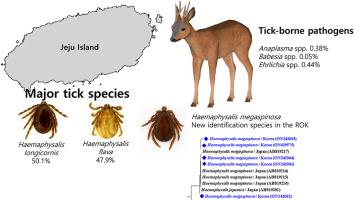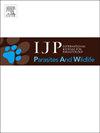Species diversity of tick and tick-borne pathogens from roe deer (Capreolus pygargus tianschanicus), including new record of Haemaphysalis megaspinosa (Acari: Ixodidae), in Jeju Island, Republic of Korea
IF 2.2
3区 医学
Q3 ECOLOGY
International Journal for Parasitology-Parasites and Wildlife
Pub Date : 2025-07-31
DOI:10.1016/j.ijppaw.2025.101125
引用次数: 0
Abstract
Hard ticks (Ixodidae family) are primary vectors of zoonotic diseases, including severe fever with thrombocytopenia syndrome (SFTSV), anaplasmosis, babesiosis, Lyme borreliosis, and ehrlichiosis. The roe deer (Capreolus pygargus tianschanicus), a key host for tick-borne diseases, is widely distributed on Jeju Island, Republic of Korea (ROK). Although the increased interactions between deer, livestock, and humans have raised concerns about zoonotic disease transmission, this area has remained understudied. Therefore, this study aimed to investigate the species diversity of ticks infesting roe deer and the prevalence of major tick-borne diseases in this region. From 2018 to 2020, 1832 ticks were collected from 154 roe deer. Four tick species were identified: Haemaphysalis longicornis (50.1 %), H. flava (47.9 %), Ixodes nipponensis (1.7 %), and H. megaspinosa (0.3 %). This study reports the first detection of H. megaspinosa in the ROK. Pathogen screening detected Anaplasma spp. (minimum infection rate, MIR: 0.38 %), Babesia spp. (0.05 %), and Ehrlichia spp. (0.44 %); however, sequencing was only successful for Anaplasma spp. These findings highlight the importance of continued tick surveillance and research on the zoonotic risks associated with emerging tick species in the ROK.

韩国济州岛鹿蜱和蜱传病原体的物种多样性,包括巨棘血蜱(蜱螨目:伊蚊科)新记录
硬蜱(硬蜱科)是人畜共患疾病的主要媒介,包括发热伴血小板减少综合征(SFTSV)、无形体病、巴贝斯虫病、莱姆病和埃利希体病。鹿(Capreolus pygargus tianschanicus)是蜱传疾病的主要宿主,广泛分布于韩国济州岛。尽管鹿、牲畜和人类之间相互作用的增加引起了人们对人畜共患疾病传播的关注,但这一领域的研究仍然不足。因此,本研究旨在调查该地区狍蜱的种类多样性和主要蜱传疾病的流行情况。从2018年到2020年,从154只狍身上采集了1832只蜱虫。共检出长角血蜱(50.1%)、黄血蜱(47.9%)、日本硬蜱(1.7%)、大棘蜱(0.3%)4种蜱类。本研究报道了韩国首次发现的巨棘球绦虫。病原菌筛查检出无形体(最低感染率,MIR: 0.38%)、巴贝斯虫(0.05%)和埃利希体(0.44%);这些发现强调了继续监测蜱虫的重要性,并对韩国新出现的蜱虫物种进行人畜共患风险研究。
本文章由计算机程序翻译,如有差异,请以英文原文为准。
求助全文
约1分钟内获得全文
求助全文
来源期刊

International Journal for Parasitology-Parasites and Wildlife
Medicine-Infectious Diseases
CiteScore
3.80
自引率
5.60%
发文量
113
审稿时长
45 days
期刊介绍:
The International Journal for Parasitology: Parasites and Wildlife (IJP-PAW) publishes the results of original research on parasites of all wildlife, invertebrate and vertebrate. This includes free-ranging, wild populations, as well as captive wildlife, semi-domesticated species (e.g. reindeer) and farmed populations of recently domesticated or wild-captured species (e.g. cultured fishes). Articles on all aspects of wildlife parasitology are welcomed including taxonomy, biodiversity and distribution, ecology and epidemiology, population biology and host-parasite relationships. The impact of parasites on the health and conservation of wildlife is seen as an important area covered by the journal especially the potential role of environmental factors, for example climate. Also important to the journal is ''one health'' and the nature of interactions between wildlife, people and domestic animals, including disease emergence and zoonoses.
 求助内容:
求助内容: 应助结果提醒方式:
应助结果提醒方式:


